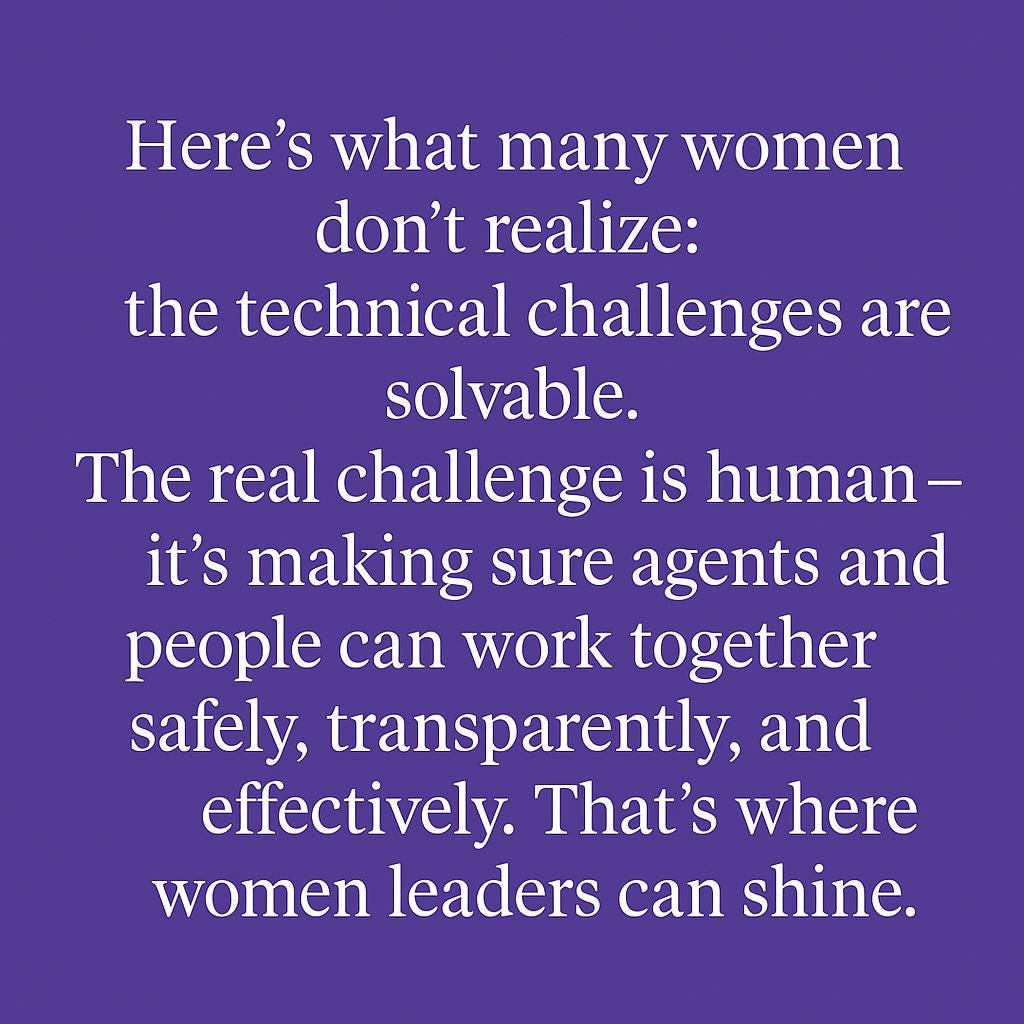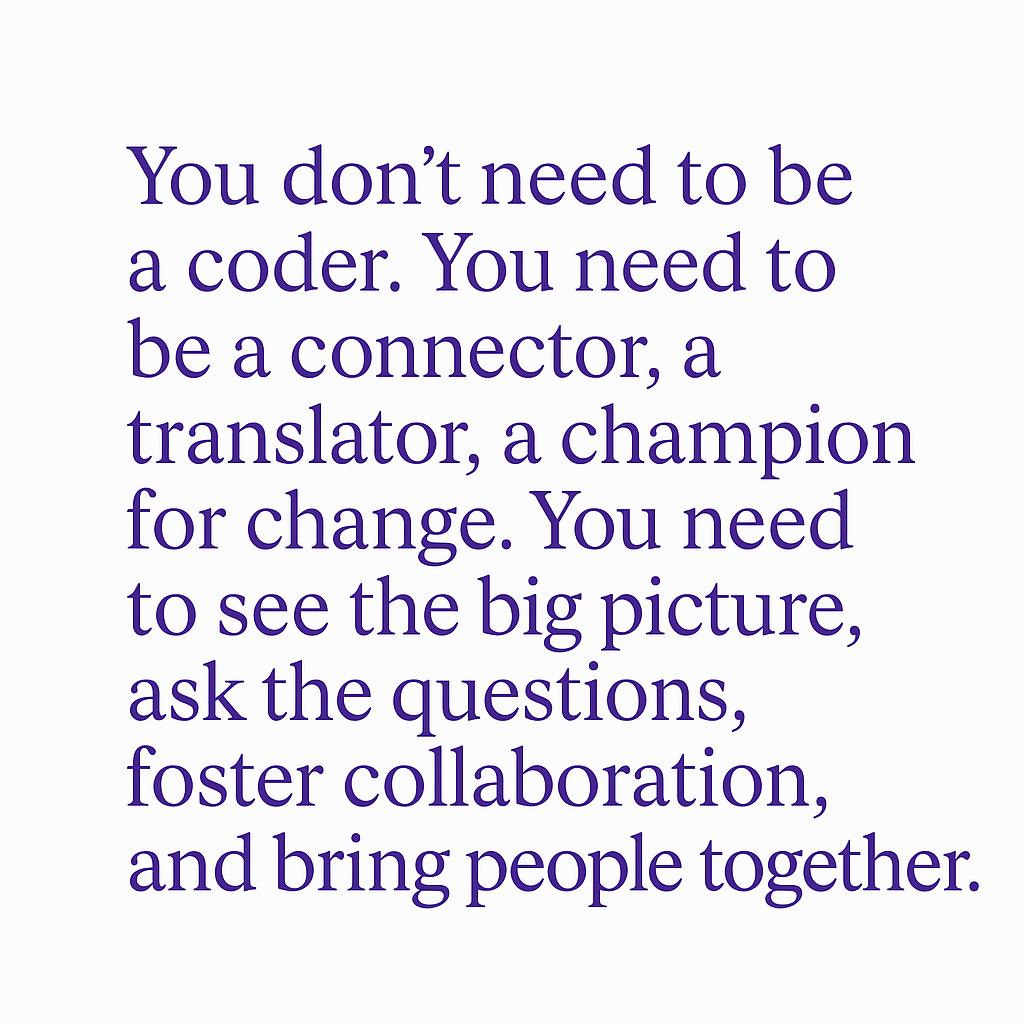💜 Hey M(AI)VENS,
☕ Estimated reading time: 8 minutes
If you’re new here, I’m Cheyenne! I write about how women can leverage AI at work (think: productivity, money, professional growth) and at home (health, hobbies, fun). Today’s edition is focused on the corporate office, but don’t fret if that’s not your world. In the next few weeks we’ve got wellness, creativity, and even pickleball-meets-AI coming your way soon.
So grab your coffee and settle in because this is a big one. On June 13, 2025 McKinsey (a global consulting firm known for advising top companies and publishing in-depth business research) dropped a game-changing report on AI in the workplace.
If you’re a woman climbing the corporate ladder (or already leading from the top), this is your moment to shine.
Let’s talk about what’s really happening with AI in corporations and why most companies are still missing the mark (but not for long). Most importantly, let’s look at how you can use these insights to leapfrog the competition, amplify your impact, and future-proof your career.
I truly believe women leaders are uniquely positioned to drive this change and benefit from it. It’s the source of my inspiration for launching the M(AI)VENS newsletter + member community —a place where women can network and learn from one another.
Let’s get into it!
💡 Everyone’s Using AI, But Where’s the Payoff?
Let’s start with the report’s title: “Seizing the agentic AI advantage: A CEO playbook to solve the gen AI paradox and unlock scalable impact with AI agents.”
Inside, McKinsey says nearly 80% of companies are now using generative AI (gen AI) in some form, but almost the same number say it hasn’t moved the needle on their bottom line. That’s what McKinsey calls the “gen AI paradox.”
In short, there’s a flurry of activity happening. But the measurable business impact? Still waiting.
Why? They say it’s because most companies are playing it safe with “horizontal” use cases. This includes company-wide copilots and chatbots that help everyone a little bit, but no one a lot. These tools are easy to roll out, but their benefits barely register in the company’s financials.
Meanwhile, the “vertical” use cases which are the ones tailored to specific business functions like supply chain, finance, or customer service, are stuck in pilot mode. They’re harder to build, require custom development, and need real organizational change. These are the use cases with the potential to transform businesses and careers.
🚧 Why the Gap?
McKinsey identifies several big reasons why vertical AI isn’t scaling:
Fragmented Initiatives: Too many disconnected pilots, not enough enterprise-level coordination.
Lack of Packaged Solutions: Custom work is hard, and most companies don’t have the right mix of talent to industrialize AI solutions.
Tech Limitations: Early large language models (LLMs) were passive, error-prone, and couldn’t handle complex workflows.
Siloed Teams: AI experts working in isolation from the business, making solutions tough to scale.
Data Gaps: Poor data quality and accessibility, especially for unstructured data.
Cultural Resistance: Fear of job loss, change, and the unknown.
Sound familiar, ladies? If you’ve ever tried to push a new technology or any new idea, project, or initiative in a big company, you know these obstacles all too well.
🤖 Enter the “Agentic Era”
Here’s where it feels futuristic. McKinsey argues that the next wave of AI—the “agentic era”—will break this paradox wide open. Instead of passive tech, we’ll have AI agents: proactive, goal-driven collaborators that can automate entire business processes, learn from outcomes, and adapt in real time.
These agents don’t just wait for you to ask a question. Instead, they monitor, plan, execute, and even escalate issues when needed. Imagine an AI that not only drafts your reports but also follows up on open tasks, coordinates with other systems, and flags risks before you even see them. Now multiply that across every function in your organization.
👩💼 What Does This Mean for Women Leaders?
Here’s why I believe the AI revolution is a once-in-a-generation opportunity for ambitious women…
The Playing Field Is Being Reset: Most companies are still figuring it out. Everyone is learning on the fly. There’s no entrenched old boys’ club of “agentic AI experts.” If you move fast, you can shape the conversation and set the standards.
Leadership Is the Bottleneck: McKinsey is crystal clear the main challenge isn’t technical, it’s human. It’s about trust, adoption, and governance. Women who excel at cross-functional leadership, empathy, and change management are uniquely positioned to lead this transition.
AI Needs Diverse Voices: AI agents are only as good as the people who design, deploy, and govern them. Diverse leadership means better and more effective AI. Your perspective is essential!
🔧 How AI Agents Transform Work
Let’s break down what agentic AI can actually do, with examples:
Automate the Complex: Agents can handle multi-step workflows, like supply chain orchestration, credit risk assessment, or customer service resolution. This frees you and your teams for higher-value work.
Supercharge Agility: Agents adapt in real time, rerouting tasks, reprioritizing work, and flagging anomalies before they become crises.
Unlock New Revenue: In e-commerce, agents can personalize offers on the fly; in finance, they can recommend tailored products; in industry, they can enable new business models like pay-per-use or subscription services.
Elevate Human Roles: As agents take over the repetitive and the routine, your job shifts to oversight, strategy, and exception handling. You become the conductor, not the drummer.
🧱 Why Architecture (and Governance) Matters
The companies that win won’t necessarily be the ones with the best AI. They’ll be the ones with the best AI architecture and governance. McKinsey calls this the “agentic AI mesh”—a framework that lets multiple agents collaborate, share context, and act autonomously, all while keeping risks in check.
🧭 Recommendations: How Women Leaders Can Leverage This Moment
M(AI)VENS, here’s your mini-playbook for standing out, leading change, and making your mark in the agentic era. McKinsey’s report indicates most companies are still in the experimentation phase. Only 1% have achieved true “AI maturity.”
So, there’s a huge opportunity across the 92% of companies that plan to increase their AI investments. This is where you step in…
1. Become the Agentic AI Evangelist
Educate Yourself and Your Team: Dive deep into what agentic AI is and how it works. Host lunch-and-learns, bring in experts and speakers, and make AI literacy a core part of your professional development and your team’s development.
Spot the Vertical Opportunities: Look for high-impact, function-specific processes in your area that are ripe for reinvention. Where are the bottlenecks, delays, or manual handoffs? That’s where agents (and you!) can shine.
2. Champion Cross-Functional Collaboration
Build Alliances: Partner with IT, data, and operations. Women are poised to form and foster collaborations that bring together diverse skills and perspectives.
Lead with Empathy: Change is scary. Use your emotional intelligence to listen, address fears, and build trust in new ways of working.
3. Push for Strategic Alignment and Governance
Get a Seat at the Table: Advocate for direct executive sponsorship of AI initiatives. If you’re not at the leadership level, ask to participate in AI review committees, trials, and experiments. Express interest in AI efforts, projects, initiatives. The companies that succeed will have senior women leaders involved in driving the agenda. This is you. Don’t assume anyone knows you want to be involved.
If you don’t have a seat at the table, you might end up on the menu.
Shape Governance: Be proactive about setting guardrails for agent autonomy, transparency, and ethics. Diverse voices are critical to avoiding bias and ensuring fairness.
4. Invest in Upskilling and New Roles
Upskill Yourself: Learn what you can about prompt engineering, agent orchestration, and human-in-the-loop design. Look for free and low cost courses. Don’t get stuck in the past. Experts say these are the skills of the future.
Learn the lingo. Follow the headlines. Get to know the top AI companies and key players. Subscribe to a few quality newsletters and carve out time to read. The more familiar you are, the more confidently you can talk about AI with leaders in your organization. Confident conversations can lead to inclusion in decision-making.
Mentor and Sponsor Others: Help other women (and allies) build AI fluency. Champion new roles and career paths that didn’t exist a year ago.
5. Redesign, Don’t Just Optimize
Rethink Processes: Don’t just add AI to old workflows, try reimagining them. Where can agents take over routine steps? Where do humans add the most value?
Pilot Boldly, Scale Wisely: Start with a high-impact pilot, measure results, and then scale. Document lessons learned and share them widely.
Look for Revenue Potential: Explore where AI could increase revenue in your current role or business line, whether it’s streamlining a client process, offering a premium AI-powered service, or identifying new income streams entirely. Added money equals added value, and leaders who bring in revenue always stand out. 💸
6. Embrace the Human Side of AI
Lead the Culture Shift: The agentic era is as much about mindset and culture as it is about technology. Foster a “human + agent” culture which values learning, adaptability, and collaboration.
Model Vulnerability and Curiosity: It’s okay not to have all the answers. Ask questions, experiment, and model lifelong learning.
Shameless plug: Share M(AI)VENS with another woman who could use a confidence boost around AI. Forward this edition, post about it, or send her to womenai.substack.com to subscribe.
⏳ Why Now Is Your Time
The next three years may define the next thirty. The companies and leaders who master agentic AI now will set the pace for everyone else. And because the rules are still being written, there’s never been a better time for women to step up, lead boldly, and shape the future.
So, M(AI)VENS, let’s get to work. Let’s close the AI gap, not just for ourselves, but for everyone who comes after us. The future is ours to lead.
📋 Quick Summary Checklist
The “gen AI paradox” is real: lots of AI, little measurable impact (so far).
Agentic AI (autonomous, proactive agents) is the next frontier.
The main barriers are human, not technical: trust, governance, and process reinvention.
The time to act is now: educate, collaborate, govern, upskill, redesign, and lead the culture shift.
You’ve got this. And I’m cheering you on, every step of the way.
Cheyenne 💜
Founder, M(AI)VENS
Source: McKinsey June 2025 Agentic AI Report and related analyses
Copyright © 2025 M(AI)VENS. All rights reserved.





